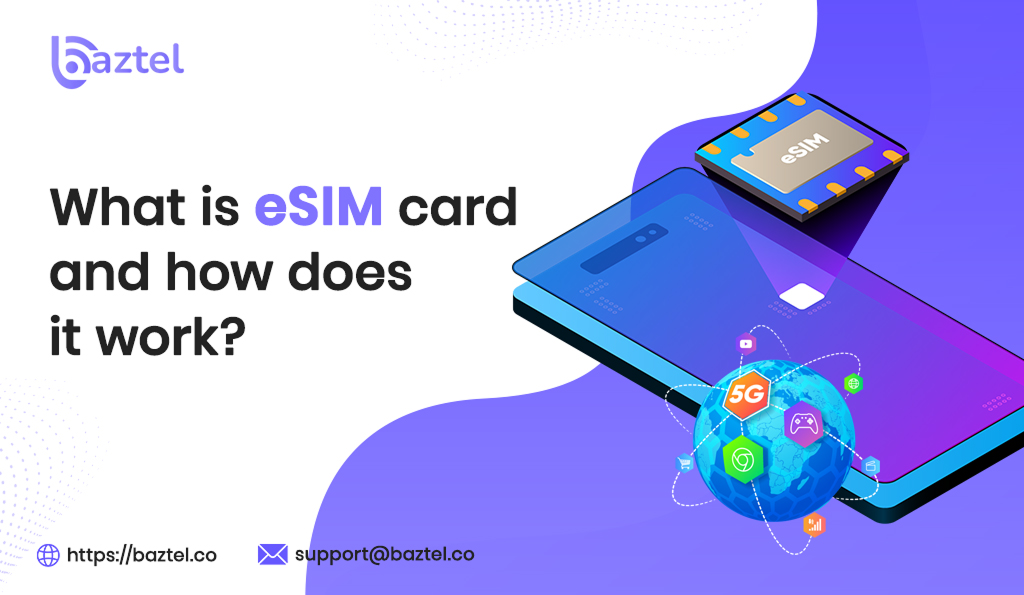Ever wished you could forgo the hassle of swapping out a SIM card when switching phones or carriers? Well, the future is now: it’s called an eSIM! So in case you’re still among those scratching their heads trying to figure out what is eSIM and how it works, you aren’t alone. An eSIM is a little chip embedded in your device through which you can change the carrier without relying on a physical (external) card. It sounds almost magical, doesn’t it? And in this blog, we will cover all the scramble of eSIMs—from how they work to just how revolutionary these things are to simplifying mobile interfaces for you!
What is eSIM?
Simply put, an eSIM, or Embedded Subscriber Identity Module, is a digital SIM embedded into a smartphone or device. Rather than inserting or changing a physical SIM that activates a connection with a mobile network, an eSIM embedded in your hardware can activate a cellular plan without requiring a physical card.
An eSIM card is basically an embedded chip that does what SIM cards do, but without the interference of a physical card. So instead of running around trying to find an extra tiny card for your carrier changeover or international travel, you will need just a couple of taps to change networks or update your cellular plan in your settings.
The eSIM is the most convenient, secure, and future-proof way to be connected! Thanks to eSIM technology, a whole new world of smartphones, smartwatches, and tablets have been eSIM-enabled, allowing users to enjoy a simplified and flexible mobile lifestyle.
How Does an eSIM Work?
Just like any other technology, understanding what is eSIM and how it works helps one appreciate its benefits. eSIM types are digital SIM cards that are embedded within a device but are not physical SIM cards like the old original version. Let’s understand the technology of eSIMs and the processes of activation and provisioning.
The Technology Behind eSIM
An eSIM is a tiny chip integrated directly into your device’s motherboard. It works very much like a physical SIM card, holding your mobile network and user identity data. The fundamental difference is, however, that the eSIM card can be remotely programmed with software. That makes it easier for users to download and flip through various profiles of carriers without inserting or taking out a physical SIM card. It conforms to the GSMA standard so that eSIM technology-enabled devices are compatible with international networks.
Due to this integrated approach, eSIMs are stronger, more secure, and more adaptable. They’re not exclusive to smartphones; smartwatches, tablets, and even laptops are now incorporating eSIM technology, extending its application beyond mobile devices alone.
Activation and Provisioning Process
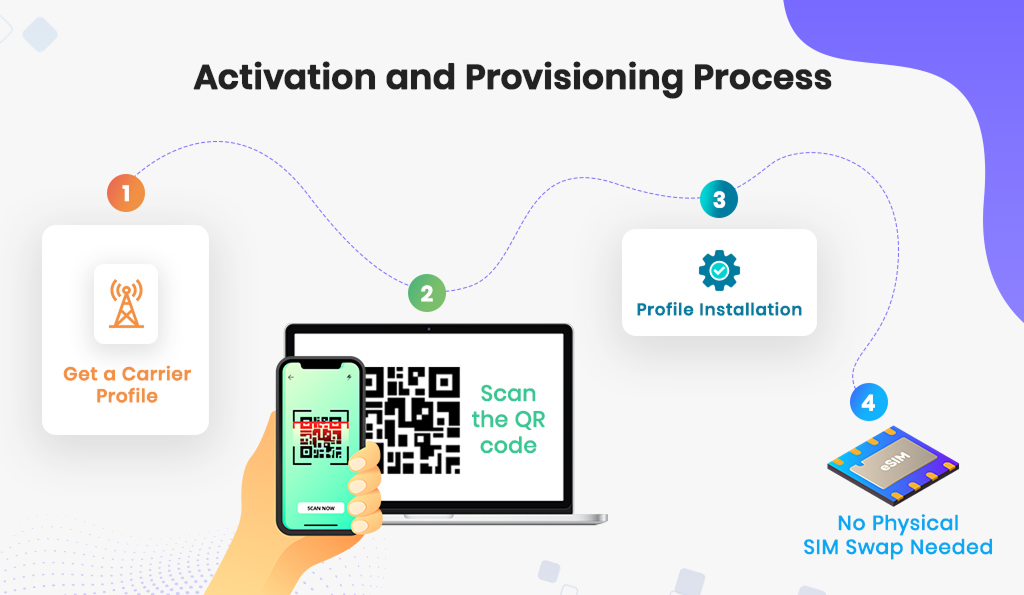
Activating an eSIM involves downloading a carrier profile onto your device. This is where the real convenience comes in! Here’s how the process works:
1. Get a Carrier Profile
You need an eSIM-enabled carrier to activate an eSIM. Once you buy a plan, your carrier sends you a QR code or an activation code.
2. Scan or Enter the Code
Through your device’s settings, scan the QR code or input the activation code manually. This will initiate the download of your carrier profile to your device.
3. Profile Installation
After the profile is installed, your device is then ready to use the mobile network like a normal SIM card. You can also have multiple profiles (e.g., work and personal) and switch between them without having to physically swap anything.
4. No Physical SIM Swap Needed
Once activated, you can easily change carriers or plans directly from your device’s settings. This is particularly useful when abroad or changing to a new provider.
With the eSIM, what is eSIM becomes clear: it’s a smarter, more versatile way to connect to mobile networks without the hassle of traditional SIM cards.
Advantages of eSIM Cards
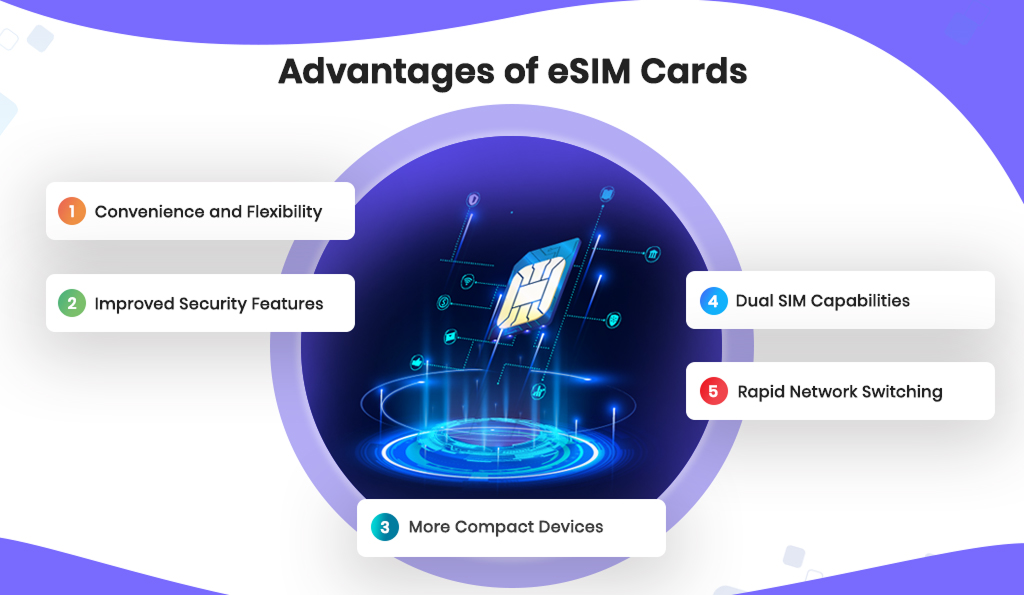
eSIM cards are changing the way we stay connected. The small but powerful digital SIM card has a lot of advantages to offer, making them a desirable alternative for consumers. Some of the most evident advantages of an eSIM card are
Convenience and Flexibility
The greatest advantage of eSIM cards is convenience. Switching carriers or upgrading a phone does not require the user to physically take a SIM card out. One can simply configure, switch, or change his or her mobile plan from the settings of the phone. In this sense, eSIMs are a true solution to the cumbersome nature of handling tiny physical SIM cards, making them perfectly the right match for world travelers or those often changing networks.
Improved Security Features
As eSIM cards are embedded in the device, they are far superior in security compared to normal SIMs that can be easily stolen or misplaced. eSIMs are much harder to steal and tamper with. The other advantage lies in the fact that, being electronic, eSIMs have better encryption and authentication mechanisms against cyberattacks, fraud, and other infringements, leading to safety.
Dual SIM Capabilities
Another fabulous advantage that eSIM cards come with is that one can own two different numbers at the same time. Most of the presently available devices with eSIM support dual SIMs; for instance, one physical SIM and an eSIM. This is good news for anyone who would like to separate their work and personal phone numbers or for someone traveling abroad who wants to stay connected to a local network without having to give up their home number.
Rapid Network Switching
It’s faster and easier to change mobile networks or networks on an eSIM. You can download the carrier profile rather than waiting for a SIM card to arrive in the mail or be installed in your device. This means you can change carrier plans without any interruption, and it’s especially helpful if you’re a frequent traveler or if you’re in a remote area with several carrier options.
More Compact Devices
Because eSIM cards don’t require the physical real estate that a SIM slot requires, manufacturers can build thinner, more lightweight devices. This may result in thinner smartphones, longer battery life, or more space for other hardware. The unused space may also enable better water and dust protection, strengthening the devices.
eSIM vs. Traditional SIM: A Comparative Overview
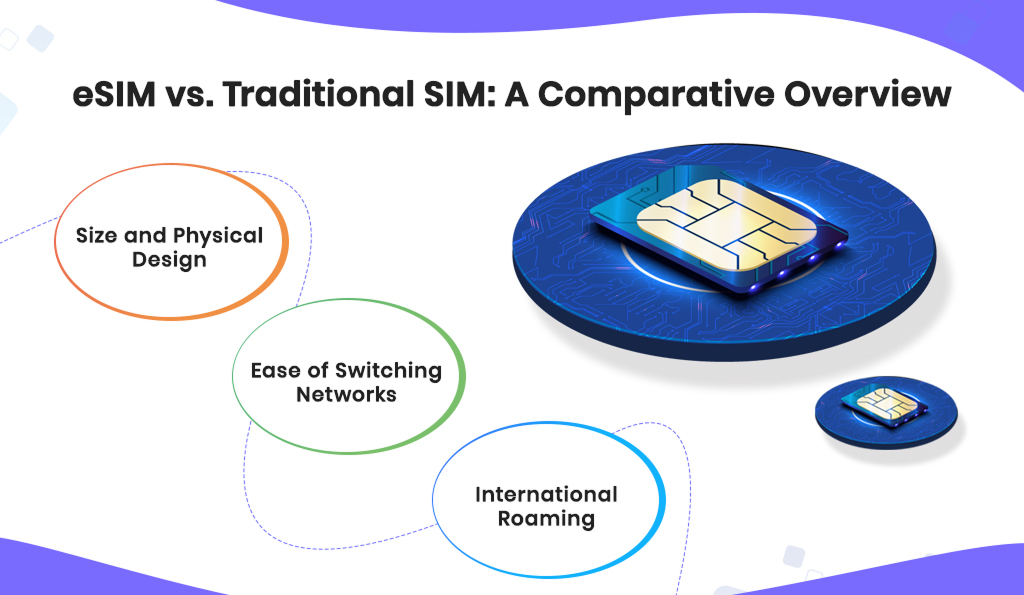
As far as SIM cards are concerned, eSIM technology is a modern alternative to the traditional SIM card. Both do exactly the same job of connecting your device to the cellular network but differ in a few aspects. Let’s see how eSIMs and traditional SIM cards measure up on several key factors:
Size and Physical Design
Standard SIM cards are insertable with dimensions that may vary (Standard, Micro, Nano). They must be inserted into your device in order to connect to the mobile network. An eSIM, however, is embedded directly into the hardware of the device; it takes no additional space, nor can it be pulled out. This allows manufacturers to make more slender and lighter devices because there is no need for a physical SIM card slot.
Ease of Switching Networks
An old-time SIM card would see its user exchanging the home country SIM with a local one, creating inconvenience while traveling overseas in another country, although others have also been slapped by high roaming charges just for using their SIMs when abroad. eSIMs allow a user to switch to a local network in a few taps, thereby easing international roaming plan use and placing less hassle on one less physical SIM card.
International Roaming
While abroad, traditional SIM cards tend to need you to exchange your home country’s SIM for a local one, which is inconvenient. Others also encounter steep roaming charges when they use their native SIM in a foreign country. eSIMs make it possible to switch to a local network with a few taps, making it easier to use international roaming plans and avoiding the hassle of using multiple SIM cards.
Comparison Table: eSIM vs. Traditional SIM
| Feature | eSIM | Traditional SIM |
| Size and Design | Embedded in the device, no physical card | Removable, comes in different sizes (Nano, Micro, Standard) |
| Switching Networks | Easy to switch networks via software, no physical SIM swap | Requires removing and replacing SIM card |
| International Roaming | Easier to activate local plans while traveling, no need for multiple SIMs | Requires purchasing a local SIM or activating international roaming plans |
| Device Compatibility | Supported by newer devices (smartphones, tablets, wearables) | Standard in most existing devices |
| Security | Higher security, tamper-proof and embedded directly into the device | Can be lost or stolen easily, less secure |
The chart above demonstrates that there are many advantages for eSIM over traditional SIM cards with regard to convenience, flexibility, and security. Whether it be switching networks, paying in a foreign country, or just wanting smaller technology, eSIM technology can provide a future-forward solution. Understanding what is eSIM card can help you make the best decision as to whether this emerging technology is the best for you.
How to Check Your eSIM Compatibility
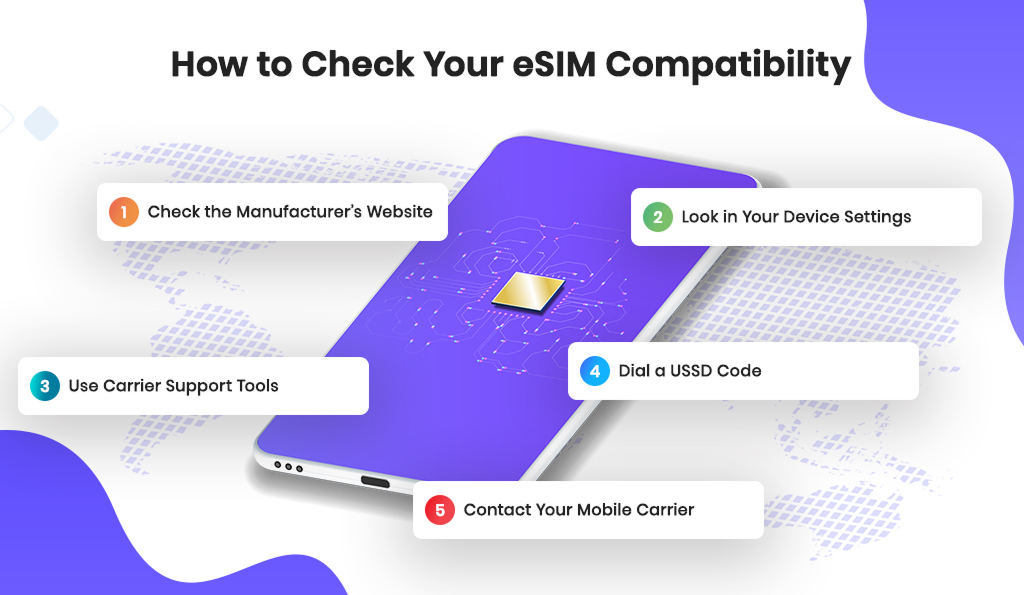
With eSIM technology quickly becoming the new standard in the modern smartphone and smart gadget space, you may be asking yourself whether or not your device currently supports eSIM. Whether you are activating a new cell plan or switching carriers and you want to avoid having to deal with a real, physical SIM card, you will want to be sure that your smartphone is eSIM capable first. Here’s how to check to see if your phone or gadget has eSIM capability.
Check the Manufacturer’s Website
The majority of major companies, including Apple, Samsung, and Google, promote eSIM-compatible phones and gadgets on their official websites. Simply go to the support or specs section of your device’s model page and see if eSIM is supported.
Look in Your Device Settings
For a quick way to verify your eSIM compatibility:
- On iPhone (iOS): Go to Settings → Cellular → Add Cellular Plan. If you see an option to add an eSIM, your phone is eSIM compatible.
- On Android (varies by manufacturer): Go to Settings → Connections → SIM Manager. If there’s an option to add an eSIM, your device supports eSIM.
Use Carrier Support Tools
Numerous cell providers provide online testing for eSIM compatibility. To find out if your device supports eSIM activation, visit your carrier’s website or enter your phone’s model or IMEI number.
Dial a USSD Code
Certain carriers enable you to find out the eSIM compatibility by a single code:
- Dial *#06# on your phone.
- If you see an “EID” (Embedded Identity Document) number in the results, it means your device supports eSIM.
Contact Your Mobile Carrier
If you are still unclear, the simplest solution is to call your carrier. Even if your phone enables eSIM activation, certain carriers may impose limits.
With more eSIM-compatible phones and devices available every year, one must confirm their device is compatible before making the transition. Whether you’re upgrading your phone or moving between carriers, following these steps will ensure a smooth eSIM activation process.
The Future of eSIM Technology
eSIM indeed has brought a paradigm shift in cellular network connectivity. eSIMs will soon become more than just a passing phenomenon and have already achieved significant acceptability. As a matter of fact, the very current and future of eSIM technology bring bright prospects before consumers as well as industrial companies alike. Let us now penetrate deeper into the market trend, adoption level, and possibilities of eSIM technology in the forthcoming times.
Industry Trends and Adoption Rates
With demand for mobile connectivity increasingly on the rise globally, eSIMs are increasingly becoming popular. The forecast appears to show that in the years to come, there will be massive growth in the number of devices with eSIM support. From Apple, Samsung, and Google-the top smartphone brands-eSIM adoption has already been rolled out to smartwatches, tablets, and even notebooks.
Adoption is gaining momentum with increasing carriers’ support for eSIMs and the technology being further standardized. By 2025, most mobile devices will be eSIM-enabled, hence offering an end-to-end connectivity experience across various networks and geographies. The automobile sector is also witnessing mass adoption of eSIMs, with eSIMs being integrated in automobiles for enhanced connectivity and service functionality.
Potential Use Cases and Advancements
The possible applications for eSIM cards are extensive and rapidly growing. With ongoing advancements in the technology, eSIMs are likely to serve a variety of functions in many areas other than smartphones. Here are some examples:
- Internet of Things (IoT): eSIMs are really disrupting the Internet of Things (IoT). Smart home appliances, wearables, and industrial IoT devices have all integrated eSIMs. An eSIM connects devices to telecommunication operators, foils physical SIM flipping, and thus switches services on and off remotely for manufacturers. This is much simpler in managing devices within an IoT environment.
- Automotive Industry: On the other hand, eSIM is penetrating into automobiles for telematics, in-car entertainment, and diagnostics. The main difference here will be the option for the motorist to switch operators with a lot more ease because he would have tied savings with an even more connected experience on the road.
- Global Roaming: It will become very simple to travel internationally without having to deal with complicated roaming solutions thanks to the mass adoption of eSIM technology. Travelers will not have to shift to an expensive roaming plan anymore, instead choosing a local carrier or affordable global eSIM plan to ensure they always connect to the best network available.
- 5G Connectivity: eSIM, increasingly, is proving to be one of the solutions for next-generation connectivity in many nations, as those countries are rolling out the 5G networks. Due to their very small size, flexibility, and efficiency in providing over-the-air provisioning, as well as little interference with traditional SIM limitations, it is assumed that eSIMs are more beneficial to the 5G devices and will hence provide their clients with speedy access to networks.
Advancements in eSIM Technology
The future of eSIMs will also include improvement in user experience and functionality. For instance, future eSIMs can support:
- Multi-profile management: Users can store multiple profiles on one eSIM and then switch between personal, business, and international profiles without a hitch.
- Remote SIM swapping: Users can switch devices or move profiles easily without going to the store or using physical SIMs, with the aid of sophisticated software.
- Augmented Security: The next eSIM technology that comes in will be even more robust in the encryption and authentication of user data.
The future of eSIM technology is undeniably bright, with continued advancements expected to reshape how we stay connected. As adoption rates rise and new use cases emerge, eSIMs will become a central part of our digital lives, offering greater flexibility, security, and convenience.
Final Words
In conclusion, eSIM technology is changing the way we connect to mobile networks, offering convenience, security, and flexibility that traditional SIM cards can’t match. Whether you’re asking, “What is eSIM?” or wondering, “What is eSIM card?”, the answer is clear: eSIMs are a game-changer in the world of mobile connectivity. From the ease of switching networks to the security of an embedded digital SIM, eSIM cards offer a more efficient and user-friendly experience.
As we move forward, eSIMs will become even more integral to how we stay connected in a fast-evolving digital landscape. Whether it’s for international roaming, IoT applications, or the coming wave of 5G connectivity, the potential for eSIM technology is limitless.
At BazTel, we’re more than just a telecom provider – we’re your global companion. With a passion for seamless connectivity and a commitment to excellence, we’ve revolutionized travel communication, ensuring that staying connected on the go is as easy as ever. Ready to discover the power of eSIM? Let BazTel lead the way to a more connected future.

 Botswana
Botswana Zambia
Zambia Congo
Congo Colombia
Colombia China mainland
China mainland Chile
Chile Chad
Chad Central African Republic
Central African Republic Canada
Canada Cameroon
Cameroon Cambodia
Cambodia Burkina Faso
Burkina Faso Bulgaria
Bulgaria Brunei Darussalam
Brunei Darussalam Brazil
Brazil Aland Islands
Aland Islands Bosnia and Herzegovina
Bosnia and Herzegovina Bolivia
Bolivia Belgium
Belgium Belarus
Belarus Bangladesh
Bangladesh Bahrain
Bahrain Azerbaijan
Azerbaijan Austria
Austria Australia
Australia Armenia
Armenia Argentina
Argentina Algeria
Algeria